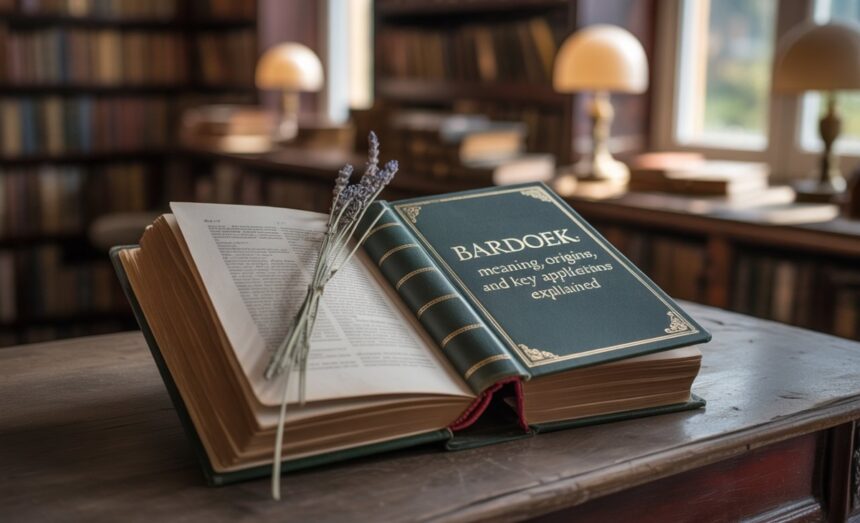The term Bardoek has been gaining attention across different contexts, ranging from cultural references to modern innovations. Although its usage can vary, the word itself carries unique depth depending on where and how it is applied. Whether you encountered “Bardoek” in historical studies, modern-day discussions, or online platforms, understanding its full meaning is essential.
This guide offers a comprehensive exploration of Bardoek—covering its origins, applications, features, and significance. By the end, you will have a clear, well-rounded understanding of what Bardoek means and why it matters today.
What is Bardoek?
At its core, It is refers to a concept that blends tradition, symbolism, and functionality. While the precise definition often depends on the context, it is widely associated with cultural heritage and practical uses.
Some key elements that define include:
- Cultural Importance: It often reflects the values, beliefs, or practices of a community.
- Practical Relevance: It can serve functional purposes in everyday life, from art to tools.
The Origins of Bardoek
To truly understand, one must look at its historical roots.
Etymology of the Word
The term “Bardoek” is believed to originate from older dialects that connected objects, symbols, or expressions with identity and tradition. Over time, it spread across regions and gained new interpretations.
Historical Significance
It has been mentioned in various historical texts and folk traditions. Communities often associated it with:
- Rituals and ceremonies that marked significant life events.
- Everyday objects crafted with symbolic meaning.
- Artistic traditions that combined craftsmanship with cultural identity.
The Cultural Role of Bardoek
Culture is where Bardoek shines most. In many societies, it is not just a concept but an embodiment of shared values and creative expression.
Bardoek in Traditions
In traditional communities, It is tied to:
- Festivals and Celebrations: Used as part of symbolic rituals.
- Art and Craft: Represented in carvings, fabrics, or tools.
- Music and Performance: Sometimes linked to folk songs or instruments.
Bardoek as Identity
Beyond its artistic role, It has become a marker of identity—allowing groups to preserve their heritage and pass it on through generations.
Modern-Day Interpretations of Bardoek
Like many cultural terms, It has evolved. Today, it is found in multiple areas, each adapting the concept to new needs.
In Creative Arts
Modern artists and designers use Bardoek-inspired styles to:
- Connect past and present in visual art.
- Highlight cultural roots in fashion and design.
- Incorporate symbolic meaning into modern creativity.
In Technology and Media
Surprisingly, It has also made its way into the digital space. Online platforms and creative communities adopt the term to:
- Represent unique branding or projects.
- Symbolize the fusion of heritage and innovation.
- Serve as a metaphor for creativity and resilience.
Key Features of Bardoek
Symbolism
It is often carries symbolic weight, representing strength, tradition, or creativity.
Versatility
It adapts easily—whether as an object, cultural reference, or modern metaphor.
Timelessness
Even as times change, It is continues to hold relevance—bridging past, present, and future.
Applications of Bardoek
It is not confined to a single area. Instead, it has multiple applications across society.
1. In Art and Design
Artists use Bardoek as inspiration for:
- Patterns and motifs in paintings.
- Jewelry, clothing, and textiles.
- Sculptures and decorative pieces.
2. In Education
Schools and cultural institutions use Bardoek as a case study for:
- Teaching about cultural preservation.
- Highlighting artistic innovation.
- Connecting students with heritage.
3. In Daily Life
It is inspired objects or practices can be part of:
- Ceremonial decorations.
- Home crafts or handmade goods.
- Cultural souvenirs or gifts.
Bardoek in Global Context
While rooted in tradition, It has global relevance.
- Cross-cultural Exchange: Communities share their versions of Bardoek, influencing art and trade.
- Tourism: Travelers often encounter in local markets or museums.
- Global Awareness: Digital platforms spread the concept, making it more accessible.
Why Bardoek Still Matters Today
In a world of constant change, It is remains a symbol of stability and identity. It matters because:
- It preserves culture in modern times.
- It inspires creativity for future generations.
- It acts as a bridge between communities worldwide.
Challenges Surrounding Bardoek
Despite its importance, It faces challenges:
- Commercialization: Mass production may reduce authenticity.
- Loss of Tradition: Modern lifestyles can overshadow cultural roots.
- Misinterpretation: Without context, its meaning can be diluted.
The Future of Bardoek
Looking ahead, It has potential to grow further.
Preservation Efforts
Cultural organizations are working to document and protect traditions for future generations.
Innovation
Designers and creators are finding new ways to reinvent Bardoek—making it relevant in modern lifestyles.
Digital Expansion
As more communities go online, It is gaining digital recognition, ensuring it remains part of global conversations.
How to Appreciate Bardoek
If you want to engage with meaningfully, consider these steps:
- Learn the Origins – Understand the culture it comes from.
- Support Local Creators – Buy authentic Bardoek-inspired goods.
- Respect the Symbolism – Use it with cultural awareness.
- Share Knowledge – Educate others about its significance.
Conclusion
It is more than just a word—it is a living concept that combines heritage, creativity, and functionality. From its roots in cultural traditions to its modern applications in art, technology, and global exchange, It is continues to hold deep meaning.
By appreciating and supporting, we ensure its legacy endures for generations. Whether you view it as a cultural marker, a creative symbol, or a practical expression of tradition, It is remains a vital part of human identity.







